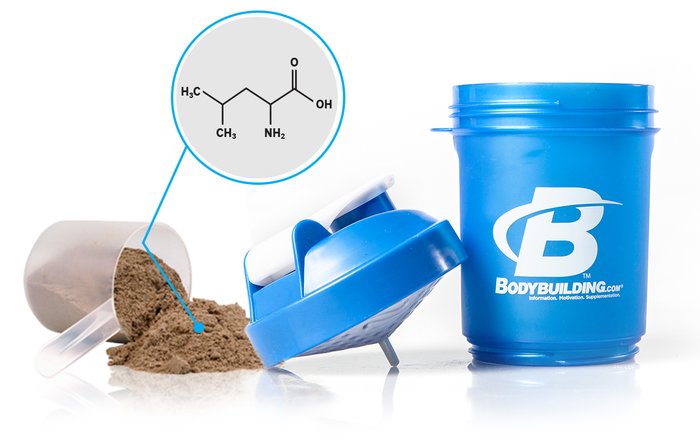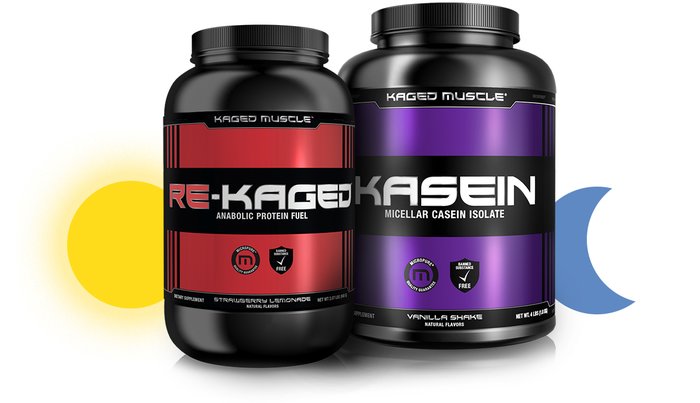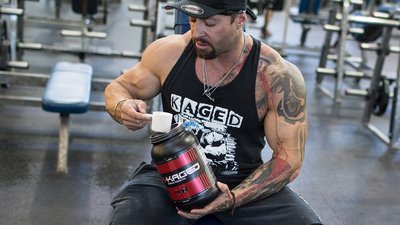From the time we first start hoisting weights and chasing gains, we're told to think about proteins and their amino acids as "building blocks" for muscle growth. It brings to mind an image of an unfinished building, climbing higher and getting more solid with each scoop. But that's just an image. What actually happens when you toss back a scoop of protein post-workout?
The "building block" metaphor only tells us part of the story. In fact, one of the fundamental roles of amino acids is to provide important biological and biochemical signals for growth and recovery, especially after heavy exercise or sports performance.
Here's what you need to know about the role protein plays in your quest for maximum muscle growth—and maximum recovery between your intense workouts!

Tilt the Anabolic Scales in Your Favor
Over the course of a day, your body fluctuates between two processes: muscle protein synthesis or "anabolism," and muscle breakdown or "catabolism." Both are necessary and inevitable. So don't fear catabolism—it's part of life.
Over time, though, the key to making gains in muscle mass is to make sure that your time in anabolism outweighs your time in catabolism. This is known as "net protein balance" or "net protein synthesis," and when you're doing things right, yours is positive, not negative.
After taking a protein supplement, there is a short and robust period of elevated blood amino acids, known as hyperaminoacidemia, which stimulates greater than normal amounts of muscle protein synthesis and anabolism. Guess what else stimulates amino acid levels? Hard training! It produces a profound anabolic response—especially when you consume protein either before or after training (or both).[1,2]
So, what is so special about the protein in this equation? There's been plenty of research trying to determine that. The most critical component, it seems clear, is the amino acid leucine.

Leucine is the Key
Leucine is one of the three branched-chain amino acids (BCAAs) in protein, and by far the most powerful of the three. It acts as a signaling molecule to stimulate muscle growth, primarily by activating a powerful anabolic process known as the mTOR pathway.
The leucine contained in whey protein is one factor that promotes hyperinsulinemia and supports blood insulin, which drives anabolism even higher while also decreasing the rate of catabolism.[3] Remember: Both anabolism and catabolism are happening all the time in your body. By both increasing anabolism and chipping away at catabolism, leucine can help on both sides of the scale.
In fact, researchers have concluded that the leucine content in any particular protein is what most determines the muscle protein synthesis response your body will experience.[4]
So, what protein has the highest known levels of leucine? Whey protein. This, as much as anything, is why whey remains the optimal post-workout dietary protein. To optimize the amount of leucine you get from your whey, look for products that offer at least 25 grams of protein per serving.

Take Your Protein to the Next Level
A significant amount of scientific literature has concluded that whey protein promotes anabolism, increased strength, muscle, and fat loss. However, some research indicates it can also have greater positive effects on things like gut health and immunity better than other protein sources.[5,6]
Of course, all of this is based on your body being able to digest the protein as efficiently as possible. This is where some newer advances in protein technology may help—such as digestive enzymes. When proteolytic enzymes are combined with whey isolate, the result is a semi-predigested protein or "hydrolyzed" protein.
This can have a number of positive effects:
- Hydrolyzed whey protein is absorbed at a faster rate from the small intestine than complete milk proteins.[7,8]
- Hydrolyzed whey protein stimulates plasma insulin two times greater than complete milk proteins alone. This could lead to decreased muscle breakdown and increased shuttling of nutrients into fatigued muscle (promoting enhanced recovery).[7,8]
- Hydrolyzed whey protein elicits the greatest availability of amino acids for up to three hours after ingestion. In fact, this effect was 37 percent greater after taking in hydrolyzed whey protein than after ingesting a complete milk protein supplement.[7,8]
To get an idea of how these enzymes affect the absorption kinetics of whey protein, research shows that when whey protein is combined with digestive enzymes, amino acid absorption increases to a rate of about 8-10 grams per hour.[9] So, if you consume 20-40 grams immediately post-workout, you should be getting a steady stream of protein for as much as 2-4 hours afterward.
What About Those Longer Stretches of Time?
If you're looking for the most efficient way to get protein to your muscles fast, whey is the way to go. But what about when you have longer stretches of time in front of you—like bedtime?
Currently there is no other protein source on the market that provides greater sustained amino acid delivery than high-quality micellar casein.[10] The casein shake before bed is a classic bodybuilder ritual, and for very good reason.
Not to be mistaken for inferior quality calcium caseinates, micellar casein is the purest form of casein protein. Casein proteins are pH sensitive, causing them to thicken in the acidic environment of the stomach. The proteins' ability to form a gel in the stomach slows down the digestion rate of the intact proteins, providing a sustained release of amino acids into the bloodstream.
This unique property makes casein ideal for nighttime or prolonged periods throughout the day without protein. Drinking just 30 grams of micellar casein has been shown to promote an incredible seven-hour sustained plateau in blood amino acids, thereby reducing catabolism by 34 percent, and boosting anabolism by 31 percent, for seven hours after ingestion.[11]
Whey during the day, casein at night; it's a one-two punch that has both research and decades of anecdotal support behind it. There's no need to reinvent the wheel when it comes to protein!
References
- Tipton, K. D., Elliott, T. A., Cree, M. G., Aarsland, A. A., Sanford, A. P., & Wolfe, R. R. (2007). Stimulation of net muscle protein synthesis by whey protein ingestion before and after exercise. American Journal of Physiology-Endocrinology and Metabolism, 292(1), E71-E76.
- Morton, R. W., Murphy, K. T., McKellar, S. R., Schoenfeld, B. J., Henselmans, M., Helms, E., ... & Phillips, S. M. (2017). A systematic review, meta-analysis and meta-regression of the effect of protein supplementation on resistance training-induced gains in muscle mass and strength in healthy adults. British Journal of Sports Medicine, bjsports-2017.
- Manninen, A. H. (2006). Hyperinsulinaemia, hyperaminoacidaemia and post-exercise muscle anabolism: the search for the optimal recovery drink. British Journal of Sports Medicine, 40(11), 900-905.
- Norton, L. E., Wilson, G. J., Layman, D. K., Moulton, C. J., & Garlick, P. J. (2012). Leucine content of dietary proteins is a determinant of postprandial skeletal muscle protein synthesis in adult rats. Nutrition & Metabolism, 9(1), 67.
- Sánchez-Moya, T., López-Nicolás, R., Planes, D., González-Bermúdez, C. A., Ros-Berruezo, G., & Frontela-Saseta, C. (2017). In vitro modulation of gut microbiota by whey protein to preserve intestinal health. Food & Function, 8(9), 3053-3063.
- Brimelow, R. E., West, N. P., Williams, L. T., Cripps, A. W., & Cox, A. J. (2017). A role for whey-derived lactoferrin and immunoglobulins in the attenuation of obesity-related inflammation and disease. Critical Reviews in Food Science and Nutrition, 57(8), 1593-1602.
- Calbet, J. A., & MacLean, D. A. (2002). Plasma glucagon and insulin responses depend on the rate of appearance of amino acids after ingestion of different protein solutions in humans. The Journal of Nutrition, 132(8), 2174-2182.
- Brown, M. A., Stevenson, E. J., & Howatson, G. (2017). Whey protein hydrolysate supplementation accelerates recovery from exercise-induced muscle damage in females. Applied Physiology, Nutrition, and Metabolism, (ja).
- Oben, J., Kothari, S. C., & Anderson, M. L. (2008). An open label study to determine the effects of an oral proteolytic enzyme system on whey protein concentrate metabolism in healthy males. Journal of the International Society of Sports Nutrition, 5(1), 10.
- Boirie, Y., Dangin, M., Gachon, P., Vasson, M. P., Maubois, J. L., & Beaufrère, B. (1997). Slow and fast dietary proteins differently modulate postprandial protein accretion. Proceedings of the National Academy of Sciences, 94(26), 14930-14935.
- Kouw, I. W., Holwerda, A. M., Trommelen, J., Kramer, I. F., Bastiaanse, J., Halson, S. L., ... & van Loon, L. J. (2017). Protein ingestion before sleep increases overnight muscle protein synthesis rates in healthy older men: a randomized controlled trial. The Journal of Nutrition, 147(12), 2252-2261.

